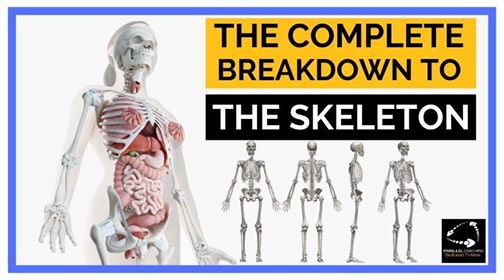The Level 2 Anatomy exam will usually have 50 questions, of which you can expect 3-8 questions relating to the skeletal system.
This blog and video will give you the complete breakdown to the skeleton and prepare you for your Level 2 anatomy exam
However, it is important to know the bones and skeletal system outside of the exam. It allows you to KNOW exactly WHAT the body should look like when observing your client, making you a human x-ray machine
Learning the bones and joints allows you to understand movement, injuries, muscle actions and how this relates across to energy systems.
So, although Bones may seem like a tedious link to coaching and instructing clients, this knowledge can impact you greatly.
Skeletal System Facts:
Bones provide structure and shape to our bodies.
The adult human skeleton is made up of 206 bones, and babies have 270. There are approx 64 bones that fuse together during the growth cycle of a child.
What are bones made of?
Bones are made of connective tissue reinforced with calcium and specialised bone cells.
Most bones also contain bone marrow, where blood cells are made.
Bones work with muscles and joints to hold our body together and allow for movement. This is called the musculoskeletal system.
The skeleton also protects delicate internal organs such as the brain, heart and lungs.
Bones contain most of our body’s calcium supply.
The body is constantly building up and breaking down bone tissue as required.
Axial and Appendicular Skeletal System
The law of the 1s and 2s is a quick tip for being able to remember the Axial and appendicular Skeleton on Exam Day
The Law of the 1s and 2s is that:
If you have ONE of them then it is part of the AXIAL skeleton:
- The cranium,
- The spine,
- The Ribcage,
- The sternum
If you have TWO of them (usually left and right of each) then it is part of the APPENDICULAR skeleton:
- Hands
- Arms
- Feet
- Legs
- Shoulder GIrdle: Scapula, Clavicle (left and right of each)
- Pelvic bones: Ilium, Ischium, Pubis (left and right of each)
The video below explains all about the Law of the 1s and 2s:
Bones you need to know for the Level 2 Anatomy Exam
The human skeleton is made up of 206 bones, including bones of the:
- Skull – including the jaw bone
- Spine – cervical, thoracic and lumbar vertebrae, sacrum and coccyx
- Chest – ribs and breastbone (sternum)
- Arms – shoulder blade (scapula), collar bone (clavicle), humerus, radius and ulna
- Hands – wrist bones (carpals), metacarpals and phalanges
- Pelvis – hip bones – ilium, ischium and pubis (3 bones each side)
- Legs – thigh bone (femur), kneecap (patella), shin bone (tibia) and fibula
- Feet – tarsals, metatarsals and phalanges.
Bone types
There are five different types of bone in the human body:
- Long bone – has a long, thin shape. Examples include the bones of the arms and legs. With the help of muscles, long bones work as levers to permit movement.
- Short bone – has a square/ cubed shape. Examples include the bones that make up the hand (carpals) and the foot (tarsals).
- Flat bone – has a flattened, broad surface. Examples include ribs, scapula, sternum and skull bones. The flat shape allows for lots of muscle attachment points.
- Irregular bone – has a shape that does not conform to the above three types. Examples include the bones of the spine (vertebrae).
- Sesamoid bone – is a small bone embedded within a tendon, for example, the kneecap (patella). Other examples are found in the hands and feet.
Level 2 Anatomy Skeletal System Mock Questions:
Q1. Which of the following is part of the Axial Skeleton?
A. Femur
B. Pubis
C. Clavicle
D. Cranium
Q2. Which type of bone are the tarsal bones?
A. Long Bone
B. Sesamoid Bone
C. Short Bone
D. Irregular Bone
Q3. What is the name of the bone in the upper arm?
A. Ulna
B. Tibia
C. Humerus
D. Clavicle
Answers to the mock questions are :
Question 1= D, Question 2 = C, Question 3 = C
If you want more mock questions like this, then you can download more Free Mock Questions: DOWNLOAD NOW
Need More Help with your Level 2 Anatomy Revision?
For Trainee FITPROS Taking Their L2 Anatomy & Physiology Exam.
Learn, Revise & Pass Your Level 2 Anatomy & Physiology Exam In Under 10-hours
(Without Having To Spend Hours Revising Or Feeling Overwhelmed)
If you want to get your revision structured, learn everything you need to know, and feel confident on exam day, then click the link below:

Dedicated to More
Hayley “ Level 2 Anatomy ” Bergman
Parallel Coaching
P.S. You can also find us on the following platforms:
Instagram: Follow Now
Facebook: Like Our Page
Twitter: Tweet Us
YouTube: Subscribe Here
More Skeletal System Blogs: HERE

